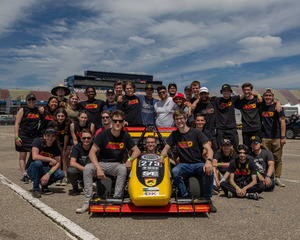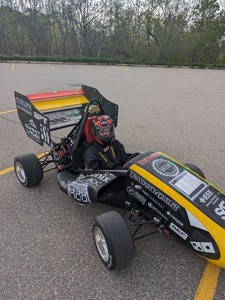Engineering Student Q&A: Matthew Verburg
We met with Matthew Verburg, a fifth-year Computer Engineering student, to hear about his experience at the University of Guelph. During his degree, he’s completed co-op terms at Electrovaya and Tesla, as well as becoming a team captain for Gryphon Racing. He discussed how these hands-on experiences developed his skills in engineering and shared some tips for students searching for summer jobs.
What has been your favourite course in your program so far and what made it enjoyable?
My favorite course so far was ENGG*4420 Real-Time System Design. It teaches us about programming embedded systems and low-level systems, which I really enjoyed. In the course, we learned about real-time operating systems, which are used widely in firmware for small devices, such as a Keurig machine. Learning to write this code really set me up well for my co-op terms, and it was enjoyable since it was directly applicable to the area of computer engineering I wanted to pursue.
What is the best part about your program?
One of the best things I found in the engineering programs is the interdisciplinary design courses each year where we’re paired up with other engineers from different programs, like mechanical, biomedical, computer, etc. We work together on an interdisciplinary project, which is similar to what we do on the Gryphon Racing team where we’re working with other disciplines toward a common goal. These courses give us relevant experience applicable to working in the industry or in co-op terms where we’d be collaborating cross-functionally.
How did you first get involved with the Gryphon Racing team, and what has been the most rewarding part of your experience as one of the team captains?

I first got involved with Gryphon Racing when a friend on the team recommended I join. At the time, I was on co-op at Electrovaya, a company that makes lithium batteries for forklifts. The timing was perfect, as the team was transitioning to building an electric car and needed help with the batteries. At my first meeting, my friend introduced me to the other team captain, and we immediately hit it off, discussing the circuits he was working on and how I would manage the batteries. The most rewarding part of the experience has been seeing the car come together. I had the chance to drive it myself and it was an incredible feeling. There was a big celebration when the car was rolling on its own, and although it was a late night, it was so much fun to see all our hard work pay off.

You completed two 8-month terms at Electrovaya as a Firmware Engineer, how did having a longer-term placement enhance your skills and growth in the role?
I found longer work terms allowed me to get more involved with the company and I got more complex projects. In the first four months, I learned more about the company, my coworkers, and the tools I would be using. The next four months, I was able to delve into project I was assigned, as well as picking up a few other projects. For the next 8-month work term, I was able to come back and continue to grow in my role as a Firmware Engineer through new and more complex projects. So, working at Electrovaya for two placements helped me develop my skills in engineering and apply the knowledge I gained in my coursework.
Tell us about the internship you completed at Tesla last year. How did this role provide you with hands-on experience in computer engineering? What did you enjoy about your internship?
I found that, compared to working at Electrovaya, which was a smaller company, moving to Tesla gave me a broader perspective on writing code and how to work in a larger organization, along with the nuances that come with it. At Electrovaya, it was common for one person to handle a major project, with maybe three other people working on the same code. However, at Tesla, I worked in a codebase shared by thousands of people, which provided a much larger-scale environment. This helped me gain hands-on experience in computer engineering by allowing me to work on large-scale projects with a bigger team, where I could collaborate and learn from experts in the field. I enjoyed the opportunity to interact with more people that acted as mentors with knowledge to help me grow both technically and professionally.
Do you have any tips or advice for other engineering students currently seeking out summer internships?
Being on the Gryphon Racing team, attending different conferences, and participating in the Formula SAE competition allowed me to network and make connections. From this, I was able to secure my internship at Tesla, simply by talking with people and sending my resume, rather than just applying online. In fact, someone from our team had already worked at Tesla in California eight months before I got my internship. So, extracurriculars provide valuable hands-on experience, which is a huge advantage. Beyond classroom learning, they allow you to tackle real-world problems and develop important skills that make you stand out to potential employers.